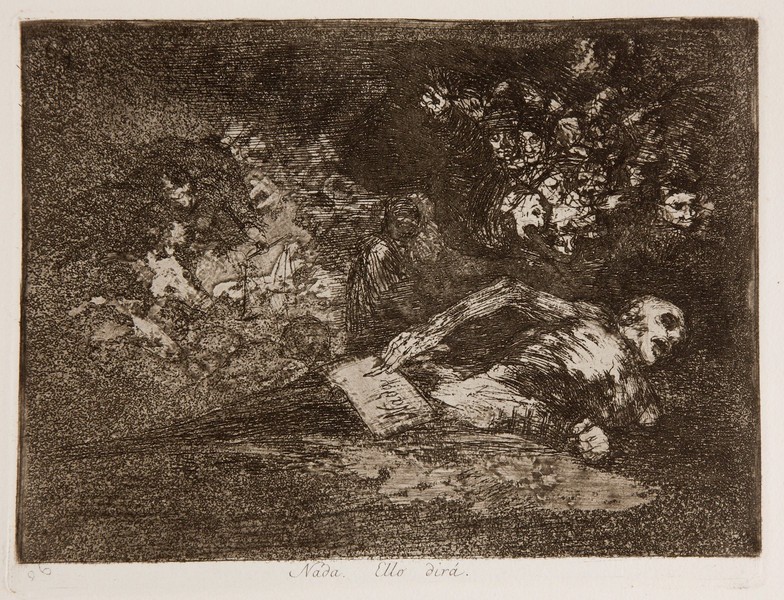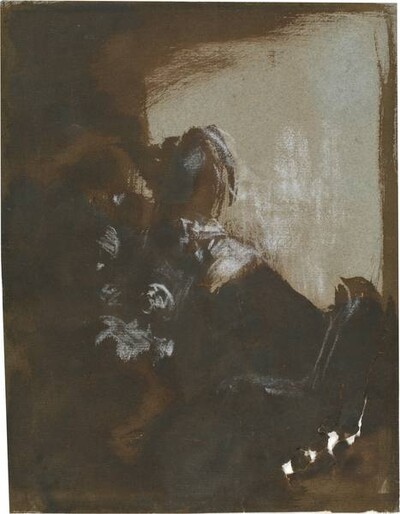- Cronología
- Ca. 1820 - 1823
- Dimensiones
- 155 x 201 mm
- Técnica y soporte
- Aguafuerte, aguatinta bruñida, lavis, punta seca y buril
- Reconocimiento de la autoría de Goya
- Undisputed work
- Ficha: realización/revisión
- 26 Dec 2010 / 05 Jun 2023
- Inventario
- 225
See Sad forebodings of what is to come.
In the first state of the proof, burin touches can be seen reinforcing the bald spots on top of the corpse's head.
The title of the print was handwritten by Goya on the first and only series known to us at the time it was made, which the painter gave to his friend Agustín Ceán Bermúdez. Thus the title was subsequently engraved on the plate without any modification from Ceán Bermúdez's copy for the first edition of The Disasters of War published by the Royal Academy of Fine Arts of San Fernando in Madrid in 1863.
In this case the title noted by Goya in Ceán's edition was Nada. It says... whereas the Madrid Royal Academy preferred to engrave the plate Nada. It will say.
A preparatory drawing is preserved in the Prado Museum.
In the foreground, a corpse lies down on its back and sits up slightly to write the word Nothing on a piece of paper. In the background, in a dark setting, a group of figures with somewhat caricatured faces that resemble masks can be made out with some difficulty. On the left side of the print, Goya has engraved a female figure reading while resting her elbow on a table and holding a scale in her other hand, probably an allegory of Justice. The scales are clearly visible in the first state of the proof, although Goya gradually covers them with the grain of the aquatint.
Several interpretations have been made of this print, perhaps one of the most literary of the entire series of The Disasters of War. It is most likely that this image refers to the situation in Spain after the end of the War of Independence. In reality, this war was both painful and painful for the population and, at the same time, absolutely useless, since once it was over, Spain returned to the same point from which it had started, that is to say, the Old Regime was reinstated in the figure of Ferdinand VII.
Nigel Glendinning has proposed a relationship between this print and the last plate of the Moral Theatre illustrated by Otto van Veen (Leiden, 1556-Brussels, 1629), as he considers that both are a meditation on death and have in common the recurrence of the corpse and the scales of Justice. He also believes that the crown in the corpse's hand could be a veiled allusion to the monarchy.
Valeriano Bozal has established a parallel between Nothing It will say this with the engravings No. 66, Strange Devotion, No. 67, This Is No Less, and No. 68, What Madness! in which the painter openly criticises certain aspects of the Church. Thus print no. 69 could be a reference to the culmination of this great deception constructed by the Church, the denial of a future life in which the believer projects himself.
To a large extent it could be said that this work continues the Baroque pictorial tradition in which the theme of Vanitas was addressed, especially in connection with some paintings by Juan de Valdés Leal (Seville, 1622-Seville, 1690) such as Finis Gloriae Mundi (1672, Hospital de la Santa Caridad, Seville). Goya must have had occasion to see it during his stay in Seville around 1790, from where he went to Cadiz to spend a period in the company of his learned friend Sebastián Martínez y Pérez (1747-1800), where he remained until 1793. The Aragonese painter may have taken from this painting the idea of Justice, which in Valdés Leal's work is alluded to by the representation of a scale in the centre, as well as the decomposing corpse and the crown.
The plate is in the National Chalcography (cat. 320).
-
Goya. Das Zeitalter der Revolucionen. Kunst um 1800 (1980 – 1981)Hamburger KunsthalleHamburg1980cat. 241
-
Goya y el espíritu de la IlustraciónMuseo Nacional del PradoMadrid1988from October 6th to December 18th 1988. Exhibited also at Museum of Fine Arts, Boston, January 18th to March 26th 1989; The Metropolitan Museum of Art, Nueva York, May 9th to July 16th 1989, Madrid curator Manuela B. Mena Marqués, scientific directors Alfonso E. Pérez Sánchez and Eleanor A. Sayrecat. 156
-
Francisco Goya. Sein leben im spiegel der graphik. Fuendetodos 1746-1828 Bordeaux. 1746-1996Galerie KornfeldBern1996from November 21st 1996 to January 1997cat. 159
-
Ydioma universal: Goya en la Biblioteca NacionalBiblioteca NacionalMadrid1996from September 19th to December 15th 1996cat. 227
-
Das Capriccio als KunstprinzipWallraf-Richartz-Museum,1996from December 8th 1996 to February 16th 1997, exhibited also in Zurich, Kunsthaus, from March 14th marzo 1997 to June 1st 1997 and in Vienna, Kunsthistorisches Museum mi Palais Harrach, from June 29th 1997 to September 21st 1997.cat. 122
-
Francisco Goya. Capricci, follie e disastri della guerraSan Donato Milanese2000Opere grafiche della Fondazione Antonio Mazzottacat. 149
-
Goya en tiempos de guerraMuseo Nacional del PradoMadrid2008consultant editor Manuela B. Mena Marqués, from April 14th to July 13th 2008cat. 114
-
Goya et la modernitéPinacothèque de ParisParís2013from October 11st 2013 to March 16th 2014cat. 108
-
Hamburg2019cat. 105
-
Madrid2017
-
Goya, grabadorMadridBlass S.A.1918cat. 171
-
Goya engravings and lithographs, vol. I y II.OxfordBruno Cassirer1964cat. 189
-
Vie et ouvre de Francisco de GoyaParísOffice du livre1970cat. 1112
-
A solution to the enigma of Goya’s emphatic caprices nº 65-80 of The Disasters of WarApollo1978pp.186-191
-
Goya y el espíritu de la IlustraciónMadridMuseo del Prado1988pp.436-438, cat. 156
-
Catálogo de las estampas de Goya en la Biblioteca NacionalMadridMinisterio de Educación y Cultura, Biblioteca Nacional1996cat. 287
-
HamburgHirmer2019p. 313
-
ZaragozaGobierno de Aragón y Fundación Bancaria Ibercaja2017p. 246
-
ParísPinacoteca de París2013p. 154
-
Goya. In the Norton Simon MuseumPasadenaNorton Simon Museum2016pp. 114-151

